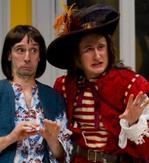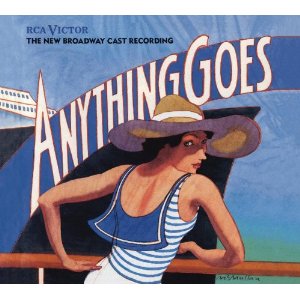SITE GUIDE
SEARCH
REVIEWS
REVIEW ARCHIVES
ADVERTISING AT CURTAINUP
FEATURES
NEWS
Etcetera and
Short Term Listings
LISTINGS
Broadway
Off-Broadway
NYC Restaurants
BOOKS and CDs
OTHER PLACES
Berkshires
London
California
New Jersey
DC
Philadelphia
Elsewhere
QUOTES
TKTS
PLAYWRIGHTS' ALBUMS
LETTERS TO EDITOR
FILM
LINKS
MISCELLANEOUS
Free Updates
Masthead
A CurtainUp Review
The Liar
|
"The unimagined life’s not worth living."
— Dorante
|

David Johnson as Cliton (L) and Aubie Merrylees as Dorante (R)
(Photo credit: Mark Garvin) |
With Pierre Corneille’s The Liar, Ives has adapted a play that is, itself, an adaptation. Corneille drew heavily from Juan Ruiz de Alarcon’s La verdad sospechosa or The Suspicious Truth which, incidentally, played at Gramercy Arts Theatre in NYC in last fall. Curtainup reviewed The Liar in Washington DC and New Jersey.
The setup, briefly: Dorante, a young man who has perfected the art of lying to gain his ends, arrives in Paris. In short order he finds a servant, Cliton, who can only tell the truth. After encountering young ladies walking in the Tuileries, he sets his sights on a potential fiancée, who is secretly engaged. Typical comic ingredients include rascal, servants, confidantes, mistaken identities, twins, bombast, and light romance— all done in iambic pentameter with rhyming couplets, which may sound deadly but isn’t. In addition, an awareness of this-is-theater runs through the piece along with self-awareness on the part of some characters. At one point Dorante says that he "shows us the Commedia we’re all masked for."
Ives’s approach to this adaptation is more about the way the plot fits into the meter and rhyme than the other way around, which would be the normal route for writing an original play. Ives revels in wordplay. His deft lines, full of contemporary winks, turn on their tails. (This playwright, you may recall, invented Unamunda, his own nonsense language.) I’d love to have been there as he arranged this whole affair — translating from the French while injecting hilarious fresh references in rhyme. He must have been laughing aloud as he put this together.
In 17th century Paris the theater celebrated talk, artifice and formality. Actors on the proscenium stage largely faced the audience head-on to present their lines. In the Lantern’s contemporary production actors address each other from various angles within a performance space surrounded on three sides by audience. Madcap entrances and exits take advantage of the stage configuration—but otherwise, other than a bizarre dual, there’s precious little action. So although energetic cast members handle cadence with dexterity— and they’re all really funny— the play seems long.
Ives has massively modernized The Liar’s language, but his staging goes half the distance. Wouldn’t it have been fun to see Lantern ditch the set piece approach, kick out the jams and get physical with it?
It’s a good sign when sound designer/composer Christopher Colucci’s name is listed in a program. It means they’re going for musical creativity. During transitions we hear his unusual creation that includes speeded up harpsichord accompanied by vocalizations. It would have been wonderful to hear the strains woven under the scenes as well. Meghan Jones ‘s bright and versatile scenic design, lighted by Shon Causer, works. As director Kathryn MacMillan says, "The set does what the language does."
While you may often crave food for thought at the theater, sometimes you just want to enjoy a show that has all the heft of froth on a latte. This ultra-light concoction delivers intelligently designed nonsense that teases and tickles the funny bone.
|
The Liar by David Ives, adapted from Pierre Corneille
Directed by Kathryn MacMillan Cast: Jake Blouch, Sarah Gliko, Dave Johnson, Emilie Krause, Aubie Merrylees, Emily Rogge, Peter Schmitz, Matt Tallman Scenic Design: Meghan Jones Lighting Design: Shon Causer Costume Design: Maggie Baker Sound Design and original music: Christopher Colucci Nov 1- Dec 2, 2012 Approx 2 and a half hours including one 15 minute intermission Reviewed by Kathryn Osenlund based on 10/09/12 performance by Lantern Theater Company at St. Stephen’s Theater, 10th and Ludlow Sts. |
|
REVIEW FEEDBACK Highlight one of the responses below and click "copy" or"CTRL+C"
Paste the highlighted text into the subject line (CTRL+ V): Feel free to add detailed comments in the body of the email. . .also the names and emails of any friends to whom you'd like us to forward a copy of this review. Visit Curtainup's Blog Annex For a feed to reviews and features as they are posted add http://curtainupnewlinks.blogspot.com to your reader Curtainup at Facebook . . . Curtainup at Twitter Subscribe to our FREE email updates: E-mail: esommer@curtainup.comesommer@curtainup.com put SUBSCRIBE CURTAINUP EMAIL UPDATE in the subject line and your full name and email address in the body of the message. If you can spare a minute, tell us how you came to CurtainUp and from what part of the country. |

Slings & Arrows- view 1st episode free
 Anything Goes Cast Recording
Anything Goes Cast RecordingOur review of the show
 Book of Mormon -CD
Book of Mormon -CDOur review of the show

